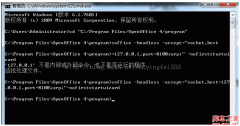导航的实现
虽然表格列出了目录中的一些图像,但用户还需要一种查看表格中未出现的图片的方法。要真正实现分页器的导行,则需要一套标准的链接:首页、上一页、下一页和尾页。
清单 3. 分页器导航
|
// Append navigation
$output = ' Showing items ' . $limit_start . '-' .
min($limit_start + $limit_step - 1, count($images)) .
' of ' . count($images) . '
';
$prev_start = max(0, $limit_start - $limit_step);
if ( $limit_start > 0 ) {
$output .= get_table_link('<<', 0, $limit_step);
$output .= ' | ' . get_table_link('Prev',
$prev_start, $limit_step);
} else {
$output .= '<< | Prev';
}
// Append next button
$next_start = min($limit_start + $limit_step, count($images));
if ( $limit_start + $limit_step < count($images) ) {
$output .= ' | ' . get_table_link('Next',
$next_start, $limit_step);
$output .= ' | ' . get_table_link('>>',
(count($images) - $limit_step), $limit_step);
} else {
$output .= ' | Next | >>';
}
$output .= ''; |
最后还要编写 get_image_link() 和 get_table_link() 函数,让用户将缩略图展开成完整的图像。注意,脚本 index.php(以及后面要创建的 expand.php)只在这两个函数中调用。这样就很容易改变链接的功能。事实上在下面与 Sajax 进行集成时,只有这两个函数需要修改。
清单 4. get_image_link、get_table_link 实现
|
function get_table_link ( $title, $start, $step ) {
$link = "index.php?start=$start&step=$step";
return '' . $title .'';
}
function get_image_link ( $title, $index ) {
$link = "expand.php?index=$index";
return '' . $title . '';
} |
放大图片
现在有了一个可用的分页器为用户提供一些缩略图。相册的第二项功能是允许用户单击缩略图来查看全图。get_image_link() 函数调用了 expand.php 脚本,我们现在就来编写它。该脚本传递用户希望展开的文件的索引,因此必须在此列出目录并获得适当的文件名。随后的操作就很简单了,只需创建病输出 image 标记即可。
清单 5. get_image 函数
|
function get_image ( $index ) {
$images = get_image_list ( 'images' );
// Generate navigation
$output .= ' '; ';
return $output;
} |
接下来还要提供与分页器类似的导航机制。“上一张” 导航到编号为 $index-1 的图像,“下一张” 导航到编号为 $index+1 的图像,“返回” 则回到分页器。
清单 6. get_image 导航
$output .= 'Viewing image ' . $index .
' of ' . count($images) . '
';
if ( $index > 0 ) {
$output .= get_image_link('<<', 0);
$output .= ' | ' . get_image_link('Prev', $index-1);
} else {
$output .= '<< | Prev';
}
$output .= ' | ' . get_table_link('Up', $index, 5);
if ( $index < count($images) ) {
$output .= ' | ' . get_image_link('Next', $index+1);
$output .= ' | ' . get_image_link('>>', count($images));
} else {
$output .= ' | Next | >>';
}
$output .= ''; |
最后创建一个简单的 HTML 容器,将其命名为 expand.php。


 ';
';



